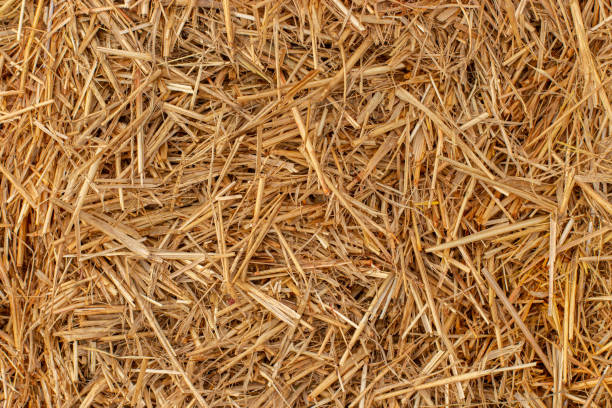
Everyone uses straw and hay interchangeably – but did you know that they are not the same? Let’s look at the major differences between the two farm materials and understand how they are used.
The 8 Differences Between Straw and Hay
They might look the same, but there are very distinct differences between hay vs straw. Mainly, they are set apart by their materials used, how they were processed, and their intended purposes.
The table below perfectly illustrates how each material differs from the other.
| Factors | Straw | Hay |
| Material used | Grain stalks | Dried legumes or grass |
| Processing | Chaff and grain are removed | The whole plant is harvested prior to drying |
| Seeds | None | Yes |
| Leaves | None | Yes |
| Uses | Compost material, animal bedding, plant mulch, weaving, roofing | Animal feed |
| Nutritional value | Low | High |
| Color | Yellow to golden | Golden to greenish gold |
| Moisture | Dry | Slightly dry but may have slight moisture |
Straw vs Hay: Understanding Each
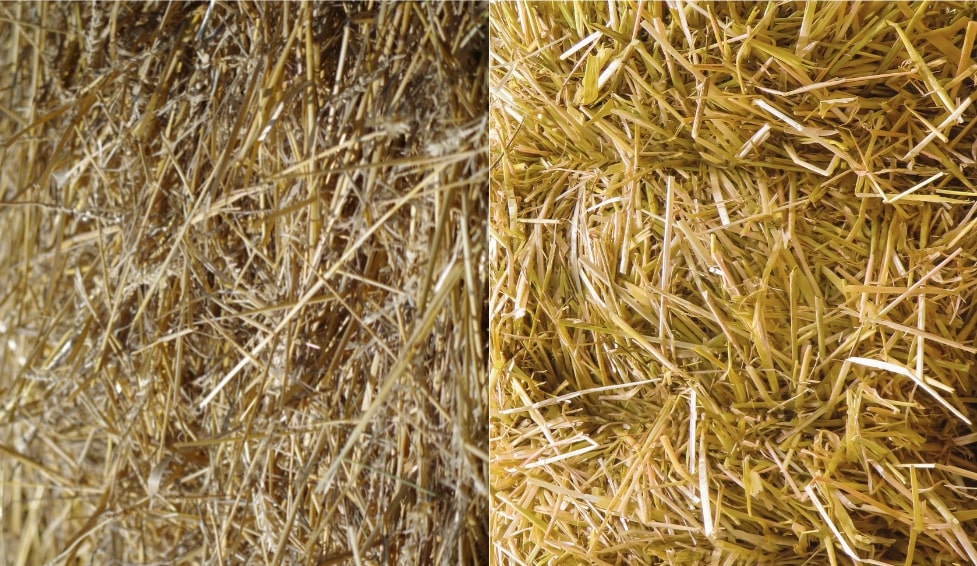
Many can be misled into thinking that straw and hay use the same materials. Let’s look at how each uses raw materials differently.
1. Materials Used
This is probably the most important factor in determining the difference between straw and hay. Let’s see how each one is dissimilar from the other.
Straw
Straw is made from crop plants in which the chaff and grain have been removed. Chaff refers to the seed casing while grain refers to the seed inside the casing.
This means that grain-producing crops like wheat, barley, oats, and rice are processed to remove their chaff and grain before being turned to straw.
Hay
Hay is made up of entire plants that have been harvested and dried. These plants include legumes, such as clover and alfalfa, as well as ryegrass, bermudagrass, and fescue grass.
2. Processing
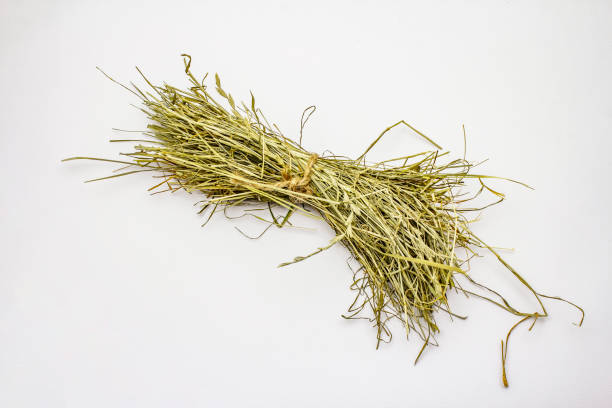
The process by which each is made affects the overall quality of each material. As a result, each ends up markedly different from the other.
Straw
Crop plants such as wheat, rice, oats, and barley are harvested before being processed. Processing takes off the chaff and grains while retaining the stalks.
This process is called threshing, where farmers separate a plant for its grains. The chaff is not suitable for humans and is usually discarded for animal use.
The stalks are then dried, collected, and packed into bales. These bales of straw are then tied with twine and sold for their intended purposes.
Hay
Farmers who intend to sell hay grow specific grasses such as timothy grass, bermudagrass, ryegrass, and fescue grass. Farmers also grow legume plants such as clover and alfalfa for making hay.
The whole plant is harvested, including the seeds and leaves. Right after harvesting, the crops are cut before getting dried out.
Once they are sufficiently dry, they are rolled into bales and sent out to their intended destinations. Hay tends to hold more water than straw, so it is best to always check for mold before feeding it to livestock.
Next, the farmer harvests the grasses and legumes when they are still growing. Usually, when these crops are harvested, the seeds are still present.
3. Seeds
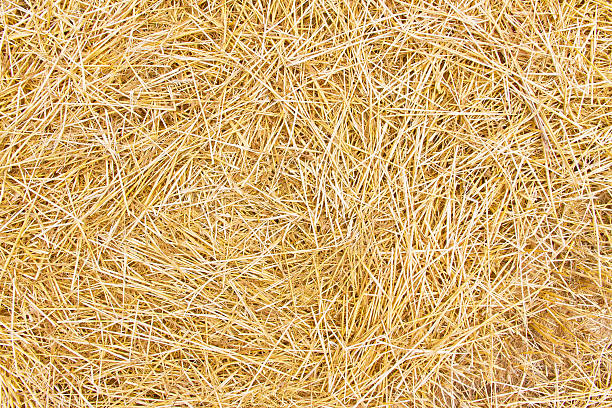
The presence of seeds can affect the use of straw and hay. This is because seeds can easily sprout unintentionally.
Straw
Straw does not have seeds in it since they are removed during processing. Consequently, straw is used extensively for gardening purposes, among others.
Hay
Hay has legume seeds and grass seeds. This makes hay more nutritional as animal feed but not suited for gardening purposes.
4. Leaves
Leaves contain nutrition, which makes any material that has leaves ideal for consumption. This is why livestock farmers prefer one over the other.
Straw
Straw does not contain any leaf parts of the plant. Straw is made of plant stalks.
Hay
Hay contains leaf parts, which makes it more nutritious than straw. As a result, farmers provide hay to their livestock.
5. Uses
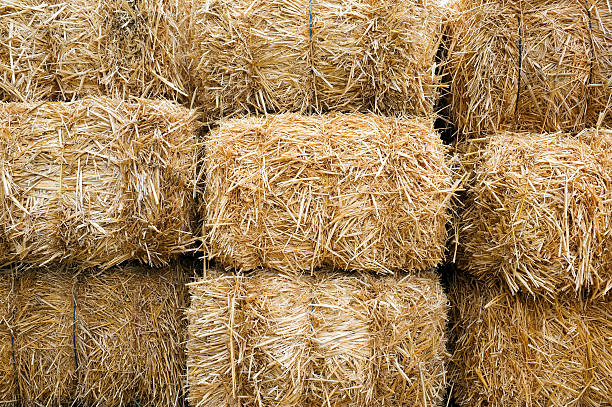
There is a reason why straw is used differently from hay. Each material has its own purpose, making each highly attractive to their intended markets.
Straw
Straw contains very little to no seeds, so it can be easily used in gardens. This means that there is very little chance of grain crops or weeds sprouting in the garden.
Straw can be used in a variety of ways. Some of the most common ways are found below:
| Compost material | Straw can be easily added to compost piles as a material to create organic soil amendment. |
| Animal bedding | Farmers use straw to cushion their livestock and create a comfortable sleeping area during the night. |
| Plant mulch | Straw is also heavily used in fruit, vegetable, and flowering gardens as mulch since it helps regulate soil temperature and moisture while preventing weed growth. |
| Basket weaving | Straw can be made into baskets that store farm produces, clothing, and farming tools and materials. |
| Roofing | Thatched roofs use straws to help keep the heat of the sun away from barns and their resident livestock. |
| Insulation | Similarly, straw is used as insulation against heat and cold when used in roofing and walls. |
| Animal feed | Farmers use straw as filler feed during harder times when hay is difficult to come by. |
Hay
Since hay contains all the nutritious content from the leaves and seeds of plants, it is used as animal feed by farmers. These include livestock such as cows, goats, and even chickens.
Some farmers throw unused hay into compost piles. When thrown into compost piles, the presence of seeds in the hay might encourage grasses and unwanted plants to grow.
If you want to avoid this, then it might be better if you simply discard the moldy hay in the safest way possible.
However, some farmers find that these unexpected seedlings can be a wonderful way to grow green cover crops to restore soil nutrients. Legume plants in particular have been found to be effective at reinvigorating soils with nitrogen.
6. Nutritional Value
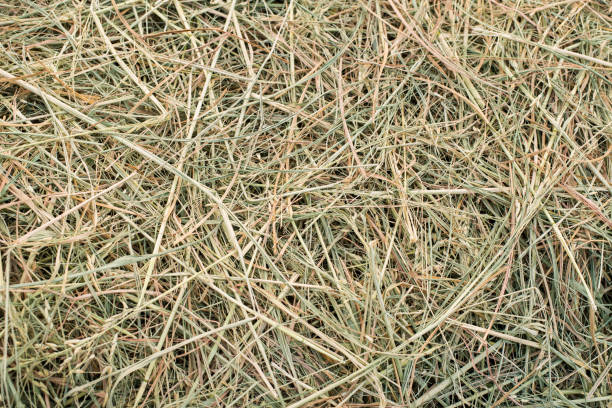
Nutrient content plays a large factor in differentiating straw from hay. This is why one is more preferred by livestock farmers than the other.
Straw
Straw contains very little nutritional value if any at all. In difficult times, some farmers may use straw to feed their animals just to keep their stomachs full.
Since they have very little nutritional value, straw is often used for basic farming purposes. These include animal bedding, compost material, basket-weaving, and even as thatch roofs.
Hay
Since hay is not as well-processed as straw, it contains the seeds and leaves of the harvested plants. These seeds and leaves contain carbohydrates, protein, vitamins, and minerals.
This means that hay is more nutritious in terms of content. This is why it is mainly used as animal feed for many farms due to the presence of seeds and leaves.
7. Color
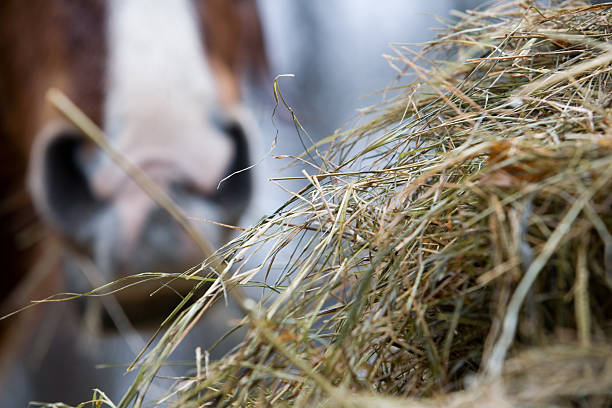
Color can help distinguish straw from hay. However, it is not the only physical factor that can help us easily differentiate one from the other.
Straw
Straw has a more yellow to golden yellow color that is typical of dried matter. The overall color tends to run in the same color family.
Hay
Hay can also be colored yellow, but tends to be in the greenish spectrum. This is because hay contains leaves, which are full of chlorophyll.
Moisture
The presence of moisture in each material will determine its individual purpose. This means that one cannot always be used interchangeably with the other.
Straw
Straw is completely dry, which makes it ideal for a lot of general use. Mulching, roofing, and wall insulation are popular uses since the dry material does not encourage fungal growth.
Hay
Hay has moisture content. As a result, hay is mostly used as animal feed and nothing else.
However, mold can grow from hay that has been wet or has not been dried out well enough. When this happens, moldy hay should be discarded safely to prevent health risks.
In Conclusion
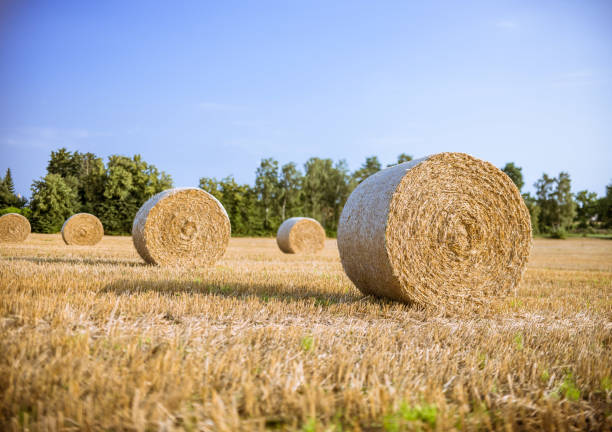
Whether you farm for plants or raise livestock, straw and hay are perfect materials for your crops and animals. The key is learning to use each other effectively.
Now that the difference between straw vs hay has been laid out in this article, you’re in a much better position to determine which one suits your purpose best.
For example, if you’re looking to use mulch in your garden, then you know that straw is a good option for you. Similarly, you now know that hay is a great food option for livestock.
Since you now know their differences, you can even help others who are struggling to understand what makes straw dissimilar to hay. If so, send this article their way!
And if you have more identifiers between straw and hay, drop a comment here. We’d love to hear from you.




